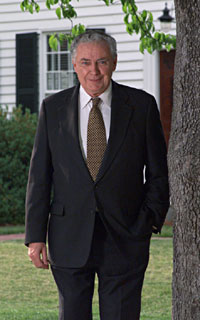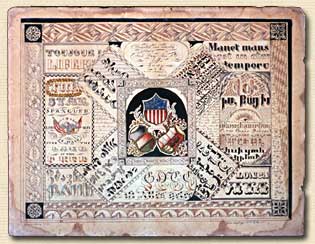Message From the President
Out of Many, One

The head of Liberty on the cover spotlights the summer journal’s visual essay on expressions of American patriotism. The objects the article pictures are from the collections of Colonial Williamsburg’s Abby Aldrich Rockefeller Folk Art Museum, a treasure-house of extraordinary paintings, carvings, textiles, sculptures, and the like fashioned by ordinary people. To me, among the most arresting is the astonishing example of complex calligraphy, a presentation piece, here in miniature.
Its careful symmetry, perfect handwriting, and vibrant color make it, in the words of a curator, “one of the most accomplished examples of ornamental penmanship found thus far.” Executed in 1852 by Gabor Nashegyi—apparently a recent immigrant to Galveston, Texas—it expresses in symbols and words Nashegyi’s appreciation for his new homeland and his thanks to a family that befriended him. Written in English, French, German, Arabic, Hebrew, and other languages, the inscriptions express more than a dozen ideas that, for all their variety, are unified by a single theme: gratitude.
The disparate tongues are the dialects of the diversity of émigrés inspired by the idea of America, people who for more than 225 years now have sought, and found, a place in the family of freedom. Nashegyi’s multilingual handiwork might easily be a metaphor for the United States, a country that in 1776 took for its motto E pluribus Unum, “Out of many, one.” We are a country less held together by a common culture than by a common set of ideas and dreams. It is not so much who we are, or where we come from, but what we think and what we believe that make us a people, one people, a nation, defined by common values, grateful for the blessings of liberty.

The handiwork of Gabor Nashegyi
- Hans Lorenz
Historian Diane Ravitch has written: “Our ability to defend, intelligently and thoughtfully, what we as a nation hold dear depends on our knowledge and understanding of what we hold dear.” The delineation of what we hold dear—in the Declaration, in the Constitution, in the speeches of such men as Patrick Henry, in the untutored masterpieces of folk art, and, indeed, in Colonial Williamsburg—is the history of our nation writ large.
The knowledge and understanding of that history are essential to being an American, no matter the language, no matter whether we are immigrants or the descendants of immigrants. The social and economic demographics of America are never static. We are a country of change and of newcomers. But we are also a nation of countrymen.
Another eminent historian, Colonial Williamsburg trustee Gordon Woods, says, “It can’t be enough to go to McDonald’s to be an American. . . . that can’t be the only adhesive that holds us together. It has to be something else. And it’s our history, and particularly the Revolution . . . that holds us together.”
That history is what inspires men and women like you and me and Gabor Nashegyi. Americans come to Colonial Williamsburg for that history, for such inspiration, to renew the sense of who we are and what we believe, that the future may learn from the past.

Colin G. Campbell
President
